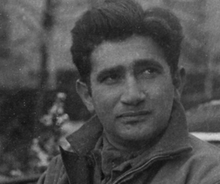Earl Mazo
Earl Mazo (July 7, 1919 – February 17, 2007) was an American journalist, author, and government official.
Earl Mazo | |
|---|---|
 Mazo pictured during World War II | |
| Born | July 7, 1919 Warsaw, Poland |
| Died | February 17, 2007 (aged 87) Bethesda, Maryland, U.S. |
| Nationality | American |
| Alma mater | Clemson University |
| Occupation | journalist |
Education and early life
Born in Warsaw, Poland, Mazo migrated to the United States as a small child with his parents, Sonia and George Mazo.[1] The Mazos settled in Charleston, South Carolina where they lived in the Hannah Enston Building.[2] Mazo would later graduate from Clemson University.[1] During World War II, he served as a public relations officer with the U.S. Army Air Force's 385th Bomb Group and was stationed in the United Kingdom.[3][4][5]
Career
Mazo reported for Stars and Stripes, the New York Herald Tribune, the New York Times, the Reader's Digest, and served for one year during the presidency of Harry Truman as a deputy assistant secretary of defense.[1] In later life, Mazo was employed as head of the professional staff of the United States Congress Joint Committee on Printing.[4]
In 1959, Mazo authored a biography of Richard Nixon, Richard Nixon: A Political and Personal Portrait.[6] The following year, he published a series of exposés on serious voter fraud in the United States which, he believed, cost Nixon the 1960 U.S. presidential election.[6][7] His reports prompted a successful appeal by Nixon to Mazo's editors to terminate the series of stories on the grounds that the U.S. could not afford a constitutional crisis at the height of the Cold War.[6] Nixon allegedly said to Mazo that "our country can't afford the agony of a constitutional crisis – and I damn well will not be a party to creating one, just to become president or anything else".[8] Mazo would later express his disappointment at the decision, believing the series would have put him in contention for the Pulitzer Prize.[6][7]
Personal life
Mazo was widowed from his first wife, but later remarried. He died at a hospital in Bethesda, Maryland from complications resulting from a fall at his home in Chevy Chase.[6][4]
Bibliography
References
- Sullivan, Patricia (February 18, 2007). "Earl Mazo, 87; Richard Nixon Biographer". The Washington Post. Retrieved March 16, 2017.
- Stockton, Robert (October 2, 1972). "Building, Notables Linked". Charleston News & Courier. pp. B1. Retrieved November 23, 2013.
- Rooney, Andy (2008). My War. PublicAffairs. ISBN 1586486829.
- "Regina Schatz and Earl Mazo". The New York Times. November 27, 2005. Retrieved March 16, 2017.
- "Report from the Front: Lt. Earl Mazo". JHSSC. Jewish Historical Society of South Carolina. Retrieved March 16, 2017.
- "Earl Mazo, 87; Nixon biographer also covered politics for New York papers". Los Angeles Times. February 20, 2007. Retrieved March 16, 2017.
- "The drama behind President Kennedy's 1960 election win". Constitution Daily. National Constitution Center. Retrieved March 16, 2017.
- Boller, Paul (1996). Presidential Anecdotes. Oxford University Press. p. 327. ISBN 0195097319.
- "Richard Nixon: A Political and Personal Portrait". WorldCat. OCLC. Retrieved March 16, 2017.